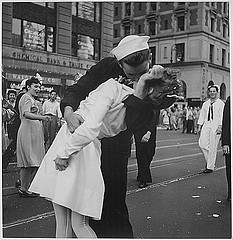Your Memoir Is History
Biff Barnes
In recent years many people have taken to calling memoir personal history. This term gives the product an autobiographical cast. However it is important to remember that there is a significant difference between memoir and autobiography. An autobiography is a full chronological account of both the life and times of its subject with an emphasis on the interaction between the person and unfolding history. A memoir has a narrower focus placing the emphasis on the author’s memories, feelings and emotions. Nevertheless there is a place for historical detail in your memoir.
 Photo from the National Archives on Flikr
Photo from the National Archives on Flikr
Maybe you don’t think of yourself as a part of the sweep of history. Think again. American Heritage Magazine ran a feature for years called “Eyewitness to History.” Anyone thinking of writing a memoir today is just such a witness. They have watched a parade of presidents and a panorama of events on the world and national stages. They have experienced the most rapid period of change in the world’s history. People have gone from listening to radio on a crystal set to the internet, from washtubs and ringers to a washer and dryer in every household, from Carter’s Little Liver Pills to knee replacements, heart transplants and gene therapy, and from Charles Lindberg’s trans-Atlantic flight to Neil Armstrong’s “giant step for mankind.”
Your life story is a document of social history to transmit to future generations. What may be more important is that your audience may need some help to understand the world you have lived in. For example, if you are writing for an audience which includes people under thirty years old words like typewriter, phonograph or ice box may have no meaning unless you provide some explanation. If you are telling stories about World War II or the Kennedy years, your readers may need some details about the times to provide a context through which to understand the stories you relate.
So, if you want to include historical details that you may not recall, where do you look? Start at home. You may have scrapbooks, diaries, journals or old letters which would add considerable spice to your memoir. If you want to know exactly what was happening on a particular day or year your local library has books like The Timetables of American History which provide details of day-to-day events, art, literature, pop culture, science and technology. Websites like the Smithsonian Institution’s American History Timeline or Digital History provide similar information. If you need details of events closer to home your local historical society will be happy to help with your research. Microfilm of newspapers is available at most local libraries.
Taking the time to add historical details to your memoir can make it much more memorable for readers from generations to come.